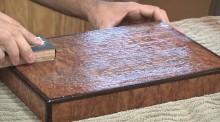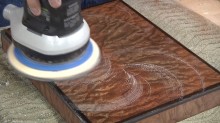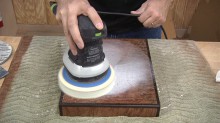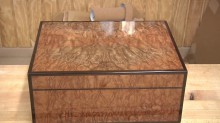213 – Rubbing Out a High Gloss Finish
Video - January 2, 2014
One of the biggest challenges woodworkers face is getting a nice smooth blemish-free finish. Let’s face it, very few of us have spray booths and our shops are far from ideal finishing environments. It’s to be expected that our finish will nearly always have dust and other pieces of debris residing within it. Fortunately, there is a way that just about ANY finish can be improved and it happens well after the final coat is applied. That process is called rubbing out.
Rubbing out is nothing more than abrading the surface until it’s nice and smooth. Take it to a high enough grit and you’ll be polishing the surface to a super high gloss. Stop sooner at a lower grit and you can achieve the perfect semi-gloss, satin, or matte finish.
The key to this process is letting the finish cure. Even after a finish dries to the touch, there is an additional period of time before the finish is up to full hardness. The harder the finish, the better it responds to rubbing out. Yes, this terminology is very hard to discuss with a straight face. Anyway, here’s a general guideline for wait times.
Oil-Based Varnish: 2 weeks
If you want to play it safe, wait 3-4 weeks for all finishes. Since finishes can differ dramatically from brand to brand and formulation to formulation and environmental conditions also play a role, you’ll want to err on the side of caution giving the finish plenty of time to cure for best results.
Rubbing out is a three-step process (not including pore-filling) that does require some specialized tools and materials. There are also lots of options and alternatives in this arena, so don’t be afraid to experiment a bit after doing some additional research on your own.
Fill the Pores
If you have an open-pored wood or one with deep grain lines, you should definitely do a pore-filling process. This can be done in a number of ways using a variety of materials, but I really like using Timbermate water-based filler. Once the pores are filled and the surface is flat and smooth, we can begin applying finish.
Stage One: Leveling
 No matter how good a finish looks, it will always have surface imperfections. To level things out, I like to sand by hand using a piece of plywood faced with cork. I use 320 grit wet/dry paper and a bit of soapy water as a lubricant. The soapy water helps prevent sandpaper clogging.
No matter how good a finish looks, it will always have surface imperfections. To level things out, I like to sand by hand using a piece of plywood faced with cork. I use 320 grit wet/dry paper and a bit of soapy water as a lubricant. The soapy water helps prevent sandpaper clogging.
Stage Two: Smoothing
 Once the surface is leveled, we can proceed with abrading the surface with increasingly higher and higher grits. I like to use Festool Platin Abrasives, 500, 1000, and 2000. Unfortunately, it seems you can only get these pads in the large 15-packs which are quite expensive. As an alternative, try Mirka Abralon pads in 500, 1000, and 2000 grit.
Once the surface is leveled, we can proceed with abrading the surface with increasingly higher and higher grits. I like to use Festool Platin Abrasives, 500, 1000, and 2000. Unfortunately, it seems you can only get these pads in the large 15-packs which are quite expensive. As an alternative, try Mirka Abralon pads in 500, 1000, and 2000 grit.
These pads work with standard hook & loop random orbit sanders and do the work of smoothing the surface quickly and efficiently. Once again, soapy water serves as a lubricant.
Stage Three: Polishing
 The final steps of the process bring the surface to a super deep gloss. White there are traditional abrasive powders that you can use for this purpose, like rottenstone and pumice, the newest formulations in automotive rubbing compounds work like a charm. You might want to experiment with various brands but the one I decided on was Menzerna, primarily based on Jeff Jewitt’s endorsement of the product. I use two formulations: IP 2000 and SF 4000.
The final steps of the process bring the surface to a super deep gloss. White there are traditional abrasive powders that you can use for this purpose, like rottenstone and pumice, the newest formulations in automotive rubbing compounds work like a charm. You might want to experiment with various brands but the one I decided on was Menzerna, primarily based on Jeff Jewitt’s endorsement of the product. I use two formulations: IP 2000 and SF 4000.
To apply the polishing compounds, I use Surbuf pads. These soft foam pads fit right onto standard hook & loop sanders. It’s a good idea to dedicate a pad for each specific compound so as to not end up with grit contamination.
 After the surface is fully polished, you should be left with a deep rich gloss that has no equal!
After the surface is fully polished, you should be left with a deep rich gloss that has no equal!
Interesting in learning more about the Humidor shown in the video? Join the Guild today!



